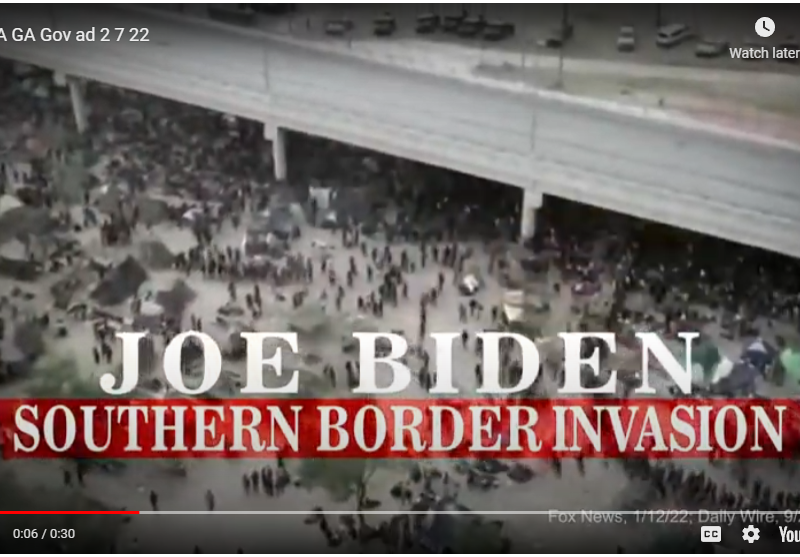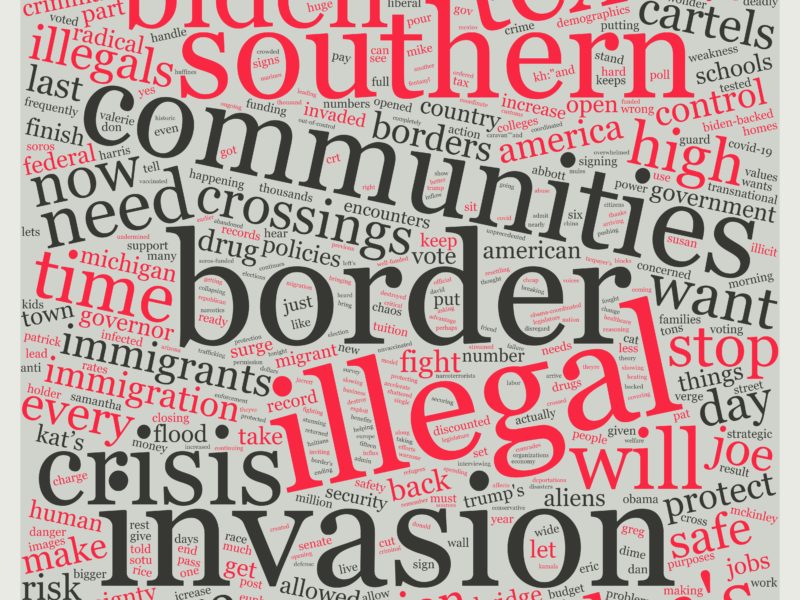This post was written by Donroy Ferdinand Jr. He’s a senior at Howard University.
In September 2021, Haitian families looking for safety made the perilous journey to the United States border to make their legal claim for asylum. Fleeing the instability of a nation suffering from a recent presidential assassination and back-to-back devastating natural disasters, they made their way to Del Rio, Texas. Finding some shade under a bridge from the intense sun of the South Texas summer, many families erected temporary shelters from whatever they could find while they waited to be able to make their asylum claim. But their temporary encampment barely lasted two weeks before all the Haitian migrants were moved to processing facilities. Most of them were then deported, many without even being given the ability to make an asylum claim.
Enter a right-wing media ecosystem that thrives off clicks from nativists’ fear-mongering headlines and images of refugees and asylum seekers at points of desperation. And a Republican Party that had been relentlessly driving a disingenuous political narrative about a “Biden Border Crisis” for the prior six months as part of their fundraising and base mobilization midterm election strategy. These forces rushed to the impromptu refugee camp shooting photos and videos to use to advance their nativist political narrative before the camp was dismantled. This imagery of the Haitian migrants in Del Rio and the temporary encampment quickly made its way to GOP political ads.
Below is an analysis of 48 paid political ads that employ this imagery. The tactical use of these images and the language that accompanies them aims to trigger racial anxieties in voters. The ad makers hope to create the false perception that there is a steady unrelenting flow of non-white migrants coming unimpeded into the United States and to trigger anti-Black racism centering Black migrants at their moment of desperation. The things Republicans are peddling in their ads do not exist in a vacuum and they are contributing to a political climate that is getting people killed.
These ads intentionally strip away the important context all the relevant context of the images and are often used to make the absurd argument that Democrats support “open borders.” Several of these ads employ the white nationalist conspiracy theory about “white replacement” and a migrant “invasion.” Not only is the language disturbing, it both amplifies and normalizes the racist lies that have inspired multiple white nationalist domestic terrorists, as seen last month in Buffalo.
The shadow of such a horrific event casts a renewed importance on the dangerous and deadly downstream consequences of the strategic racism and nativism at play in these ads. While this is a snapshot analysis in the middle of an election year, the findings expose a disturbing picture of the Republicans’ midterm strategy; One that cynically uses images of Black migrants to push a racist and nativist political message.
If you ascertain one thing from this piece, let it be this: If the racist use of imagery of Haitian immigrants continues, more people are going to die at the hands of white nationalist terrorists.
Some Brief Historical Context
The Republican ads include the images of the Haitian migrants to dehumanize them, turning them into something to fear, not understand. It is important to restore context of what was happening at that time when looking to analyze what Republicans are trying to say – or not to say – as they look to weaponize these images. However, we do not pretend to capture the full history of this story but the briefest outlines.
Haiti makes up the western half of the island known as Hispaniola, once a lucrative colony for France. The French forced enslaved people from Africa to coffee and sugar cane fields, extracting vast amounts of wealth from the island and its people. The long, genocidal process of the transatlantic slave trade was based entirely on the concept of white supremacy. It was okay (and necessary) to abuse, exploit, murder, and erase, so long as it was beneficial for those of European descent. In 1804, Haitians fought for their independence from France as part of the first successful revolution of enslaved peoples overthrowing one of the world’s strongest military powers. However, in the centuries following, financial retaliation followed from France and the United States. Self-determination for the formerly enslaved was apparently too much for them. A series of military occupations (and other non-democratic activity) followed that installed leaders that helped foreign business interests. This has left the country indebted and its people struggling. Haiti is now the poorest country in the western hemisphere. For more detail on this vitally important historical context check out “The Root of Haiti’s Misery: Reparations to Enslavers” by By Catherine Porter, Constant Méheut, Matt Apuzzo, and Selam Gebrekidan in the New York Times.
In recent years, alongside financial and political uncertainty, Haiti has had to deal with several devastating natural disasters. The month prior to these images from Del Rio that show up in Republican ads, Haiti suffered a horrific earthquake that left some 2,200 dead and over 12,000 injured, greatly damaging vital infrastructure. In the following days, Tropical Depression Grace made direct landfall on the nation causing further harm and destabilization.
Both of these natural disasters came just one month after the assassination of Haitian President Jovenel Moise. Haitians face the tragic conditions of a nation in crisis with gangs controlling much of the country, and killing and kidnapping civilians for ransom is part of daily life.
The combination of these factors led to many people in Haiti making the difficult decision to leave their home country in search of safety. The imagery used by Republicans in the ads are not something to fear, as they would like us to believe, but simply people facing harrowing conditions outside of their control doing their very best to make sure that they and their families are safe.
No, these images do NOT show Biden’s “open borders,” quite the opposite
(Ted Budd, NC Senate, first aired March 22, 2022)
While showing an image of (mostly Haitian) people under the Del Rio Bridge in an advertisement, Ted Budd, the Republican nominee for US Senate in North Carolina, says “When I’m in the Senate, I’ll vote to stop Joe Biden’s reckless open border policies.” Additionally, he displayed text saying something similar. Besides the racist dog-whistle, it is just patently untrue. Far from an “open border,” almost all the Haitians depicted in Budd’s ad were likely swiftly deported by the Biden administration.
The Biden administration has deported tens of thousands of Haitians despite the inhumane process of deporting Haitians back to a country in a state of emergency after recent natural disasters left thousands homeless, struggling with food insecurity, economic collapse, and a political system in chaos following a presidential assassination. Those that reach the U.S.-Mexico border are met by a Biden administration that has immediately expelled thousands back to Haiti, without even the opportunity to apply for asylum.
Harold Koh, a longtime human rights lawyer who served as a senior advisor and political appointee at the State Department, resigned his post in protest over the deportation of Haitians saying it violates “our legal obligation not to expel or return (“refouler”) individuals who fear persecution, death, or torture, especially migrants fleeing from Haiti.” He added that “lawful, more humane alternatives plainly exist.”
A report by Marisa Peñaloza for NPR found that Haitian immigrants are the most likely to be denied U.S. asylum, as thousands were rejected entry in the months following the images of the temporary encampment in September 2021.
So no, far from what Ted Budd and other Republicans hope to accomplish by using these images, these images are far from evidence for an “open borders” policy from the Biden administration.
Overview of the data
America’s Voice’s GOPAdTracker.com project collects racist and xenophobic ads from all over the country. We identified 58 pieces of GOP content that make use of the images from the temporary Haitian refugee encampment. Forty-eight of these were paid political advertisements. We also added 10 tweets from political candidates that used similar imagery and were reflective of the messages in the ads as a sample to help fill out the broader picture of the Republican messaging landscape on this issue.
The messages we looked at aired across 17 states. Texas (11 items) , Arizona (9 items) and Ohio (8 items) were the most common. Twenty came from sitting US Senators or competitive Senate candidates, 14 items came from candidates in House races, nine from governor or lieutenant governors or candidates, and 10 were from PACs and committees aligned with Republicans. We compiled a transcript for the language that was used in relation to the imagery creating a number of word clouds, which we further analyze below. All of the ads can be found on our database.
It should be noted that we continue to find more examples of Republicans employing this imagery as part of racial dog-whistles and fully expect this disturbing trend to continue.
The Imagery
There is little variety in the imagery used by Republicans in these ads. The images were mostly made up of overhead shots of the Del Rio Bridge, and shots of people walking across the Rio Grande, which makes up part of the U.S. Mexico border. There were two main categories: images that are close enough to clearly communicate the skin color of the migrants and images of the encampment without the individual migrant’s skin tone clearly distinguishable.
Ultimately, if we understand the strategy behind these ads to be stoking racial division, we saw the most important aspect of the visual element of these ads to be if the people in them would be perceived as Black by viewers. That being said, many of the ads included both close and far imagery. This creates an association between the two so that the far shots are remembered as having something to do with Black immigrants. The intention is a double-edged sword of bigotry: people are going to attach racist views to Black and nonblack immigrants, and xenophobic views to Black immigrants and non-immigrants.
A typical ‘close’ image
(Bo Hines, NC-13, first aired March 22, 2022)
A typical ‘far’ image
(Republican Governors Association, Brian Kemp, Georgia, first aired February 2, 2022)
Language
What the ads said is just as, if not more important, to observe and analyze. We created a transcript for the language that accompanied the imagery. From this data, we created several word clouds to help visualize and extract the core ideas Republicans were trying to communicate.
This word cloud is of all of the words in all of the ads. ‘Border’ is an outlier, appearing in just about every single one, being more than twice as common as the next most common word. If we remove this and some of the other more common words like ”Biden”, “administration,” ”Texas”, and “southern” we can see a clearer picture. Here, we find the most common words in order are as follows: illegal, invasion, communities, crisis, and crossings.
With some words taken out, it becomes more apparent what Republicans have to say about Haitian immigrants entering the country. Language is important and words have meaning, especially words that Republicans spend millions of dollars to amplify. These words are also key to understanding the dehumanization at work in these dog-whistle attacks.
Let take a look at three examples:
“Illegal”
This word is used as a descriptor before “immigrants” or sometimes “aliens. ”’ This is a dehumanizing as well as an inaccurate term. No human is “illegal.” Additionally, those depicted were likely seeking to claim asylum as a legal means of entry into the United States. The intentionally misleading use here is meant to further create a false association between immigration and criminality. A myth that has no factual basis but one that helps drive the anxieties and fears the ads look to activate.
(Jeff Fortenberry, NE-01, first aired February 9, 2022)
“Invasion”
This term invokes images of war, death, and suffering, as well as an attack on someone’s life and values. The use of this rhetoric is as absurd as it is dangerous. It echoes the “white replacement theory” and the lie that refugees and asylum seekers constitute a real “invasion” and are coming to America intent upon destroying it. These racist lies have inspired multiple white supremacist terrorists. A few of the ads, also pair these images with a coded version of the “replacement theory” which falsely claims that Democrats are intentionally facilitating non-white migration to change the white electorate. Most startling is probably how much more frequently this word was used when the people in the ad were easily identifiable as Black Clearly, there is purpose and intent with that message.
(Elijah Norton, AZ-01, first aired March 15, 2022)
“[Our] Communities”
On its own, everyone wants to value and protect their communities, however, the context it is being used in here, is incredibly dangerous. Its only purpose in these ads is to create an ingroup and an outgroup along racial lines. Combined with the other dehumanizing language it is used to represent what must be protected from the dangerous non-white other.
(Chris Jacobs, NY-27, first aired March 9, 2022)
The cruelty of placing already vulnerable people in more danger by labeling them ‘illegal invaders’ is undeniable. But while the other language and imagery may be a tad more subtle and is still deeply pernicious. The purpose of these ads is to give voters a negative association between what they are hearing and what they are seeing. This use of imagery of Black migrants for political demagoguery will have short term and lasting negative impacts on our nation. It will have an impact on the way all Americans view all Black people, all immigrants, and all Black immigrants. Republicans are tying the word ‘illegal’ to Black people in the American subconscious with candidates casually calling for the armed forces in response to their presence in the United States.
The strategic racism at work in the these dog-whistles Republican ads
In his book “Dog Whistle Politics: How Coded Racial Appeals Have Reinvented Racism and Wrecked the Middle Class,” Ian Haney Lopez defines the dog-whistle as a “strategic manipulation of racial ideas for the pursuit of power and material wealth.” Meaning dog-whistles trade in racist ideas, explicitly avoiding naming race directly while invoking negative racial stereotypes that the viewer often reacts to without making a conscious connection of the underlying racial division. Campaigns and candidates use dog-whistles as an electoral strategy to divide voters along racial lines to invoke fears of the non-white other while distracting voters from the lack of real solutions that would improve their own lives
In these ads, Republicans explicitly avoid mentions of race. Instead, they show images of Black migrants and talk about “illegal immigrants” to encode their racist message in the ad. Republicans, thankfully, would not be successful if they ran an ad that explicitly said “we want to keep all Black and Brown people permanently out of the United States because they are inherently dangerous to white people.” You can imagine the headlines and blowback a candidate would receive if they were that explicitly racist in their political ads. However, these ads look to communicate similar racist fears and anxieties but do so in more subtle ways to give both the candidate and the voter plausible deniability of the racist idea motivating the message.
The number and the money behind these ads show the initial use of these tactics in a strategic way to win voters by weaponizing the anti-Black racism and xenophobia for their own selfish benefit.
The anti-blackness woven into the fabric of America needs to be addressed in order to combat erroneous claims about all immigrants. When Americans already view racial differences as something negative and to be feared, it is much easier to label one group as ‘other’ and endanger them. i To fully address this problem will require deep and substantial change across many of our institutions. This division will continue to have a corrosive effect until such change is made. But while the problem is deep and exploiting racism for political gain is nothing new, we must continue to be vigilant about naming it where it occurs and holding those to employ this disgusting tactic accountable.
The language and tactics employed to weaponize these images is dangerous. Every time a lawmaker engages in this kind of activity they leave their constituents vulnerable to violent white nationalists and put all Americans at risk for their attempts at selfish political gain.









